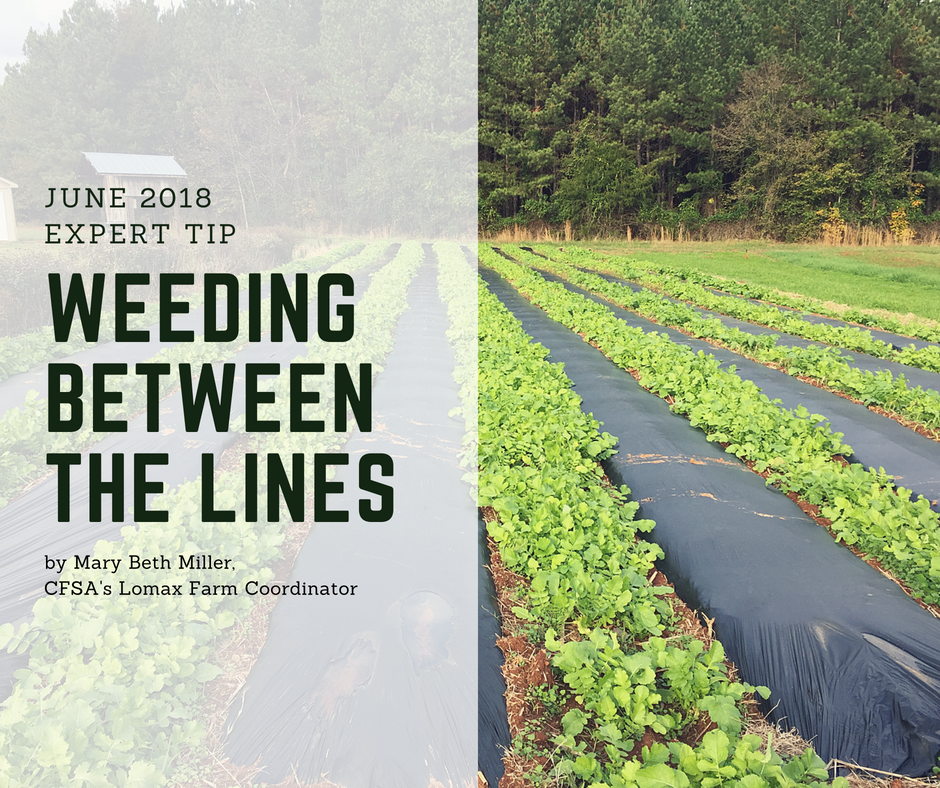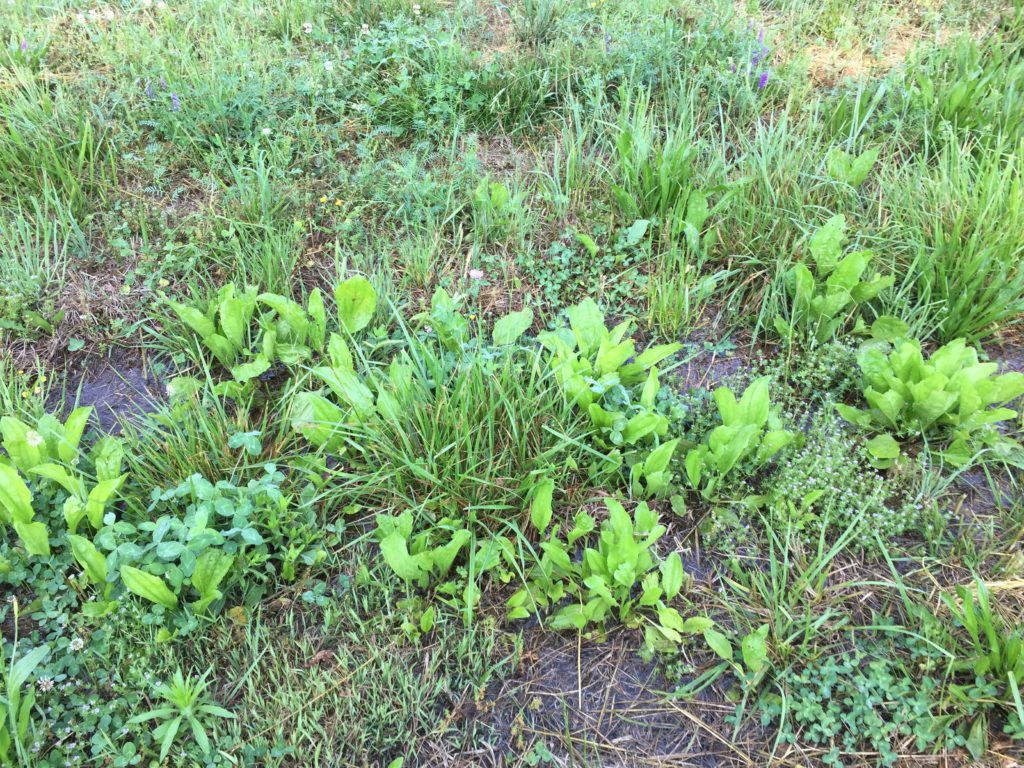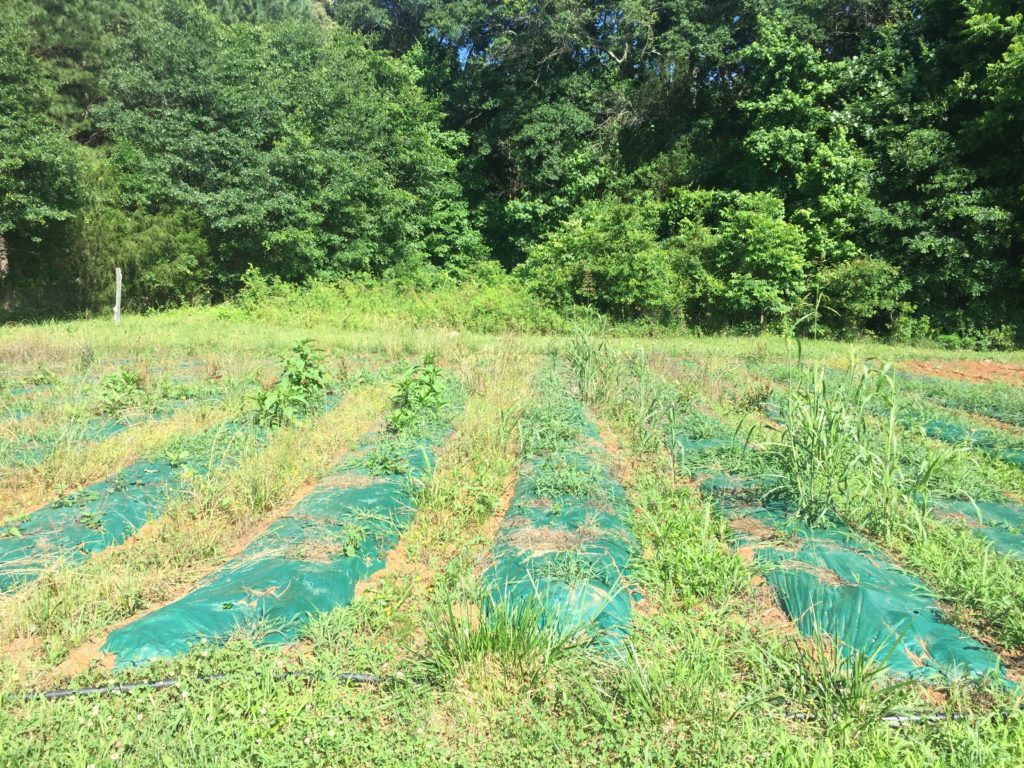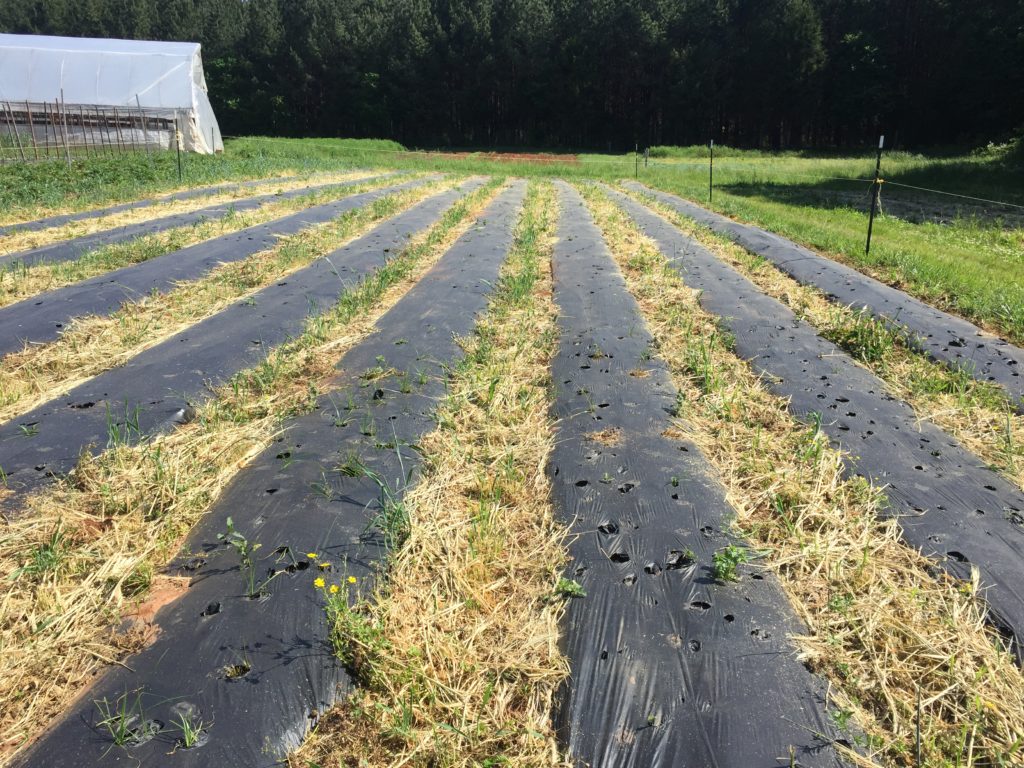by Mary Beth Miller, CFSA’s Lomax Farm Coordinator

As growers, much of our time is actually spent making sure certain plants do not grow. We affectionately refer to these plants as weeds, and whether you are growing vegetables in a small garden or grain on 100 acres, managing weeds can be costly and time-consuming.
At the Lomax Incubator Farm in Concord, NC, we use integrated pest management strategies (IPM) to tackle weeds, including mechanical cultivation, flame weeding, solarization, mulching, and smother cropping. By far, the best way to deal with weeds in organic systems is with a multi-faceted approach that incorporates the biological, physical, and chemical components of soil with targeted strategies for control.
When dealing with weeds, we use the following approach:
1. Identify the weeds.
This seems obvious, but as tomatoes have vastly different growth characteristics than blueberries, so do different weeds. Knowing what you’re dealing with is the first step in effective management, as different weeds have different growth habits, life cycles, impacts on crops, and responses to control. Five major weeds that we encounter at Lomax – Johnsongrass, Bermudagrass, pigweed, wild onions, and nutsedge – have distinct ways of reproducing and spreading: with rhizomes, stolons, seeds, bulbs, and tubers, or any combination of these. Start by identifying your most problematic and persistent weeds – the ones that take up most of your time – and get to know them.
2. Learn what the weeds are saying about the soil’s physical, biological, and chemical properties.
Different species of weeds prefer various soil conditions and will change as soil health declines or improves. Some weeds are opportunistic and will show up as indicators of soil conditions, such as low pH, poor soil structure, too much moisture, lack of specific micronutrients, or presence of anaerobic bacteria and the accompanying low levels of beneficial microbes. For example, we see broadleaf plantain and curly dock show up in turf areas with high vehicular or foot traffic, so if it starts showing up in the production fields we consider the soil’s physical properties and manage for compaction. If crabgrass suddenly dominates a field in spring, we consider the chemical properties and check calcium levels. And when Johnsongrass takes over, we know there is something out of whack with the biological community.

Plantain shows up in areas of heavy compaction.
3. Implement weed-specific strategies for control by targeting soil properties.
We start by comparing soil sample results with what weeds we’re seeing in the field to know what amendments will best enhance soil quality for crops and combat problem weeds. Take Johnsongrass (Sorghum halepense), for instance. It will grow and thrive in poor soils with low humus, low calcium, poor drainage, and where anaerobic bacteria make up the dominant microbial community. It is both an annual and perennial, spreading and reproducing by seeds and rhizomes. The first and obvious step in controlling Johnsongrass is to prevent the plant from going to seed, whether through mowing, tarping, or tilling. The second and more important step is the destruction of the rhizome where the plant’s energy is stored. A healthy, biologically active soil with the right bacteria will begin to break down the rhizome. An application of compost will feed the soil microbes and energize the good bacteria to the point where the rhizome will succumb to soil fungus disease.
Weeding Between the Lines
One problem that persists every year is weeds growing between the rows of crops, especially in between rows of plastic in areas that have been left bare all winter. We want the soil covered at all times that it isn’t being used – whether with plastic, straw, a tarp, or a living mulch – both to prevent erosion and to deter weeds from creeping in. So why treat the pathways any differently?
Here at Lomax, much of the bed prep is done the previous fall when fields are put under plastic, which is either removed or gets planted into come springtime. Fall cultivation of the soil means bringing to the surface any dormant winter annuals such as chickweed and henbit that will germinate when temperatures are cool. If left unattended, the bare ground between the rows of plastic will quickly fill with weeds as soon as the soil begins to warm up. The weeds between the rows can also scavenge nutrients or harbor pests and disease that will impact your desired crop.

Annual and perennial weeds thrive between the rows of plastic from soil left bare and compacted from tractor tires.
As a way of addressing this, we implemented a strategy for managing the weeds between the rows in three of our plots. The strategy was to sow cover crops between the rows with the goal of “choosing” the weeds we were going to deal with in the springtime.
- In the first plot where we had issues with soil compaction, we sowed tillage radishes after putting the beds under plastic in the fall. Radishes are effective at smothering persistent, early-emerging weeds, as well as weeds that grow in compacted soil and are hard to remove. The radishes thrived in the late fall and winter killed as temperatures dropped to the teens the following January. The leaves of the radishes created a thick mat that covered the soil until early spring, while beneath the soil the long taproots slowly broke down, aerating the compacted clay. The weeds that did emerge were easily cleared with a wheel hoe in the newly loosened soil, and have not persisted through the spring season.
 Tillage radishes direct seeded in between rows in the fall. In addition to breaking up heavy soil, radishes will capture and store nutrients and release them back into the soil once broken down, making the nutrients available to neighboring crops.
Tillage radishes direct seeded in between rows in the fall. In addition to breaking up heavy soil, radishes will capture and store nutrients and release them back into the soil once broken down, making the nutrients available to neighboring crops.
- In the second plot, we sowed winter rye between the beds that were destined for a late spring planting of sweet potatoes and an early summer planting of winter squash. The cereal rye easily germinates in cooler temperatures, quickly produces a ground cover, and survives low winter temperatures, giving it an advantage over early-emergent weeds in the spring. We terminated the rye by mowing, which created a thick mulch of rye straw between the rows, smothering potential weeds. Mowing can be done with a string trimmer, walk-behind flail mower, or lawn mower, depending on the width of the pathways.
 Photo of cereal rye terminated between rows of plastic in the spring. Not only is it effective at smothering other plants, cereal rye has allelopathic effects – it produces root exudates that inhibit germination and growth of weed seeds.
Photo of cereal rye terminated between rows of plastic in the spring. Not only is it effective at smothering other plants, cereal rye has allelopathic effects – it produces root exudates that inhibit germination and growth of weed seeds.
- In the third plot, we had issues with Bermudagrass and nutsedge. These weeds, while frost-sensitive, will persist underground through stored energy in their rhizomes and proliferate in the spring in bare soil. In the fall we let a buckwheat cover crop go to seed before terminating and incorporating it to make beds. The buckwheat emerged between the rows in the early fall, outcompeting and shading the problem weeds. Because it is also frost-sensitive, the buckwheat winter-killed, creating a thick mat of mulch that smothered any cool season weeds trying to emerge.
Buckwheat is a great, fast-growing, broad-leaf cover crop that will smother and shade out weeds. (Photo: Taylor Bryan)
Resources and further reading:
- Jay L. McCaman’s When Weeds Talk (2013)
- Charles Walters’ Weeds, Control Without Poisons (1991)
- K.A. Moore, J. Neal and L.K. Bradley’s North Carolina Cooperative Extension Gardener Handbook (2017)
QUESTIONS?
Reach out to Mary Beth Miller, Lomax Farm Coordinator via email or at (919) 542-2402


